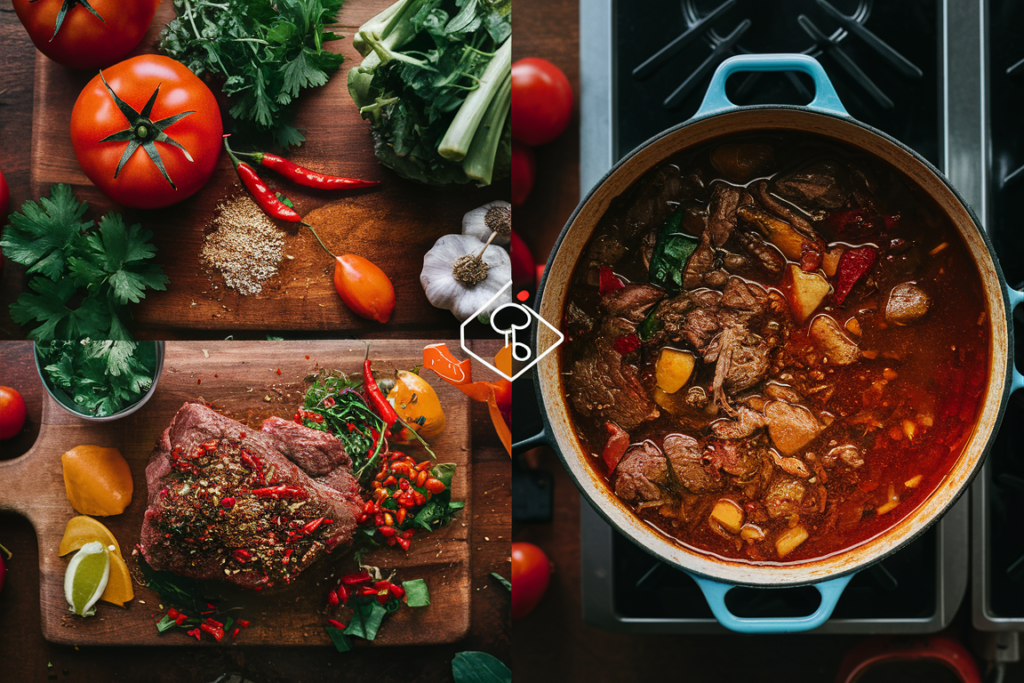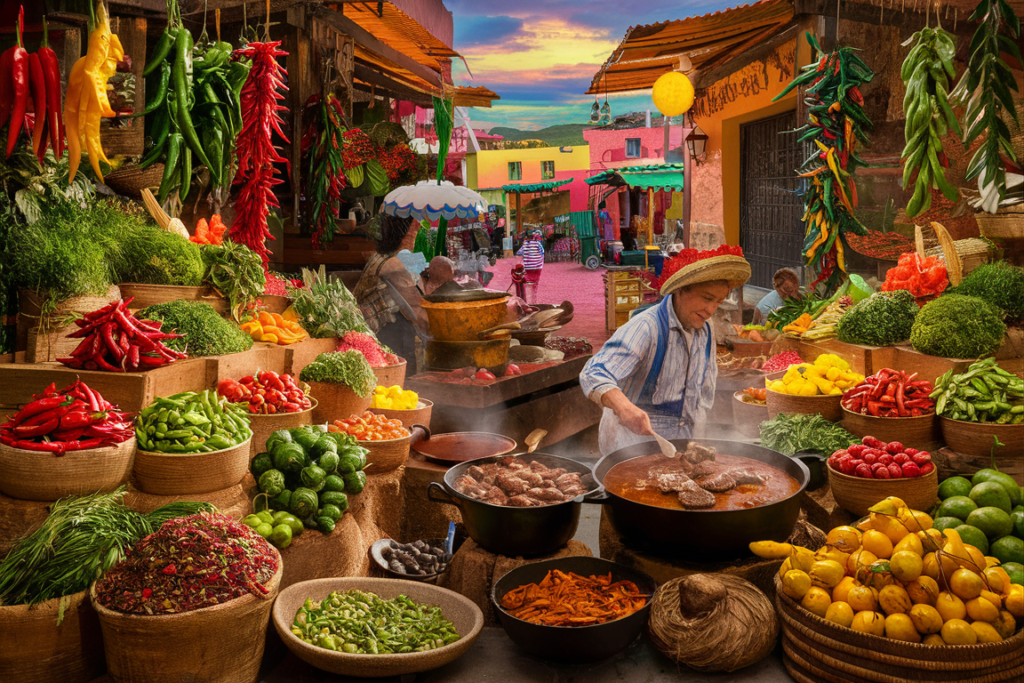Mexican Beef Stew is a warm and hearty dish made with flavorful spices, tender beef, and fresh vegetables. It’s more than just a meal – it’s a dish full of tradition and regional pride. Whether you’re an experienced cook or new to Mexican recipes, this guide will help you create this classic dish with ease.
Part 1: Introduction to Mexican Beef Stew
1. What Is Mexican Beef Stew?
Mexican Beef Stew, also called Caldo de Res, is a classic comfort food in Mexico. Its roots go back to indigenous cooking traditions. Before Spanish colonization, native Mexicans used local ingredients and slow-cooking methods to make hearty meals. Over time, the dish changed as European influences, like beef and new spices, were added to create the flavors we know today.

Traditional Variations:
- Caldo de Res: A lighter, broth-based stew featuring bone-in beef and chunky vegetables.
- Birria de Res: A more robust and spicy version, often served with tortillas.
Modern Adaptations:
- Vegetarian or vegan versions using mushrooms and legumes.
- Instant Pot variations for quicker cooking.
2. Key Ingredients in Mexican Beef Stew
A perfect Mexican Beef Stew relies on a few essential ingredients that work harmoniously to create a balance of flavor:
- Beef Cuts: Chuck roast or short ribs for their tenderness when slow-cooked.
- Vegetables: Carrots, potatoes, zucchini, and corn add sweetness and texture.
- Spices and Herbs: Chili powder, cumin, oregano, and bay leaves bring warmth and depth.
These ingredients are often enhanced with fresh garnishes like lime juice and cilantro, offering a tangy and fresh finish.
3. Health Benefits of Mexican Beef Stew
This stew is not just flavorful but also packed with nutrients. Here’s why it’s a healthy choice:
- Protein-Rich: The beef provides essential amino acids that aid muscle repair and growth.
- Vitamins and Minerals: Vegetables like carrots (vitamin A) and potatoes (potassium) add significant nutritional value.
- Low-Calorie Option: When prepared with lean cuts of beef and without excessive oil, it’s a satisfying yet calorie-conscious dish.
4. Choosing the Right Cut of Beef
The choice of beef can make or break your stew. Opt for cuts with sufficient fat and connective tissue, as these render beautifully during slow cooking.
Best Cuts for Stewing:
- Chuck roast: Affordable and full of flavor.
- Short ribs: Rich in collagen, resulting in a silky broth.
Dietary Alternatives:
- Ground beef for a budget-friendly option.
- Plant-based substitutes like seitan for vegan adaptations.
5. Traditional Spices and Seasonings
The heart of Mexican Beef Stew lies in its bold seasoning. Every spice serves a purpose in layering flavor:
- Chili Powder: Adds a smoky and slightly spicy kick.
- Cumin: A warm, earthy spice that enhances the stew’s depth.
- Oregano: Balances the dish with its aromatic and slightly bitter notes.
For authenticity, use Mexican oregano, which has a more citrusy and floral profile than its Mediterranean counterpart.
6. Authentic Techniques in Mexican Cooking
Mexican cuisine values time-honored techniques that bring out the best in ingredients:
- Slow Cooking: Whether over a stovetop or in a slow cooker, patience is key to achieving tender meat and well-developed flavors.
- Traditional Pots: Using clay pots, or cazuelas, imparts a distinct earthy taste.
7. Tools and Utensils for Preparing Beef Stew
To make the process seamless, equip your kitchen with the following:
- Essential Cookware:
- Heavy-bottomed pots for even heat distribution.
- Slow cooker or Instant Pot for convenience.
- Prep Tools:
- Sharp knives for precise vegetable cutting.
- A sturdy blender to puree tomatoes and chilies into a smooth base sauce.
Safety tip: Always handle chili peppers with gloves to prevent irritation.
8. Variations of Mexican Beef Stew by Region
Mexican Beef Stew changes subtly depending on the region, reflecting local ingredients and cultural preferences.
Northern Mexico:
- Focuses on hearty cuts of beef and simpler spices.
- Often served with flour tortillas.
Central and Southern Mexico:
- Incorporates a variety of chilies for a more complex heat profile.
- Garnished with avocado slices and crumbled queso fresco.
9. How to Balance Flavors in Mexican Beef Stew
Achieving the perfect balance of flavors is an art. Mexican Beef Stew should be:
- Spicy yet Tangy: Adjust chili quantity for heat and add lime juice for brightness.
- Sweet and Earthy: Use sweet corn and carrots to offset the spices.
Taste-test frequently and adjust seasoning throughout cooking for optimal flavor.
10. Common Mistakes to Avoid When Making Stew
Avoid these pitfalls to ensure your stew turns out perfect:
- Overcooking Beef: Leads to dry, tough meat. Stick to recommended cooking times.
- Misusing Spices: Adding spices too late can leave them raw-tasting. Toast spices briefly for better flavor.
Part 2: Step-by-Step Recipe for Mexican Beef Stew
11. Preparing the Ingredients
Preparation is essential for a smooth cooking process. Follow these simple steps:
- Wash and Chop Vegetables: Peel the carrots, dice the potatoes, and slice the zucchini. For a more rustic texture, leave some vegetables in larger chunks.
- Marinate the Beef: Coat the beef with salt, chili powder, cumin, and a splash of lime juice. Let it rest for 30 minutes so the flavors can soak in.
Pro Tip: Combine fresh and dried chilies to add more depth and richness to the flavor.bust flavor profile.

12. Cooking Methods: Stovetop, Crockpot, or Instant Pot
Choosing the right cooking method depends on your time and preferred technique. Here’s an overview:
- Stovetop: The most traditional approach, offering maximum flavor control. Requires 2-3 hours of simmering.
- Crockpot: A hands-off method that lets flavors meld over 6-8 hours.
- Instant Pot: Perfect for busy cooks, reducing cook time to under 1 hour while preserving deep flavors.
Each method ensures tender meat and a rich, hearty broth, so choose based on your schedule.
13. Creating the Base Sauce
A well-crafted base sauce is the foundation of an excellent Mexican Beef Stew. Follow these steps:
- Roast Ingredients: Place tomatoes, garlic cloves, and chilies on a hot skillet until slightly charred.
- Blend to Perfection: Combine roasted ingredients with a splash of beef stock and blend until smooth.
This sauce will infuse the stew with layers of smoky, savory flavors.
14. Searing the Beef
Searing locks in flavor and adds a caramelized depth to the stew:
- Heat oil in a heavy-bottomed pot until shimmering.
- Add beef pieces and sear on all sides until browned. Avoid overcrowding the pot to achieve an even sear.
Pro Tip: Deglaze the pot with a splash of beef broth or water after searing to incorporate flavorful browned bits into the stew.
15. Simmering the Stew to Perfection
Once the beef is seared and the base sauce prepared, it’s time to bring it all together:
- Combine beef, base sauce, and vegetables in the pot or slow cooker.
- Add enough beef stock to cover the ingredients and a bay leaf for added aroma.
- Simmer gently until the beef is tender and the vegetables are fully cooked.
Ideal Simmer Times:
- Stovetop: 2-3 hours.
- Crockpot: 6-8 hours on low heat.
- Instant Pot: 30-45 minutes under pressure.
16. Enhancing the Stew with Fresh Garnishes
Fresh garnishes enhance both the taste and appearance of Mexican Beef Stew. Here are some popular options:
- Cilantro: Brings a fresh, herbal flavor to the dish.
- Lime Wedges: Adds a zesty brightness that balances the rich flavors.
- Avocado Slices: Offers a creamy and smooth texture to complement the stew.
You can also try other toppings like diced onions, sliced radishes, or crumbled queso fresco for extra flavor and texture variety.
17. Pairing Mexican Beef Stew with Sides
To complete the meal, pair your stew with traditional Mexican sides:
- Tortillas: Warm corn or flour tortillas are perfect for dipping or as a vessel for the stew.
- Rice: A side of Mexican rice absorbs the flavorful broth beautifully.
- Cornbread: Adds a touch of sweetness and complements the spicy notes.
18. Adjusting the Recipe for Dietary Needs
Mexican Beef Stew can be customized to accommodate various dietary preferences:
- Gluten-Free: Ensure all spices and broth are certified gluten-free.
- Low-Carb/Keto: Substitute starchy vegetables like potatoes with cauliflower or turnips.
- Vegan: Swap beef for hearty mushrooms or jackfruit and use vegetable broth.
With a few adjustments, everyone can enjoy this delicious dish.
19. Storing and Reheating Leftovers
Proper storage is essential to maintain the stew’s quality:
- Refrigerating: Store in an airtight container for up to 4 days.
- Freezing: Freeze in individual portions for up to 3 months. Thaw overnight in the fridge before reheating.
To reheat:
- Stovetop: Gently warm over low heat.
- Microwave: Heat in 1-minute intervals, stirring in between to ensure even warming.
Pro Tip: Add a splash of beef broth when reheating to restore moisture and enhance flavor.
20. Serving Suggestions for Different Occasions
Mexican Beef Stew’s versatility makes it suitable for various events:
- Family Dinners: Serve with a side of rice and a simple salad for a balanced weeknight meal.
- Celebratory Gatherings: Present it with a spread of tortillas, garnishes, and Mexican beverages for a festive touch.
- Cold Weather Comfort: Enjoy a steaming bowl as a standalone dish on chilly days.
Part 3: Cultural and Culinary Insights
21. History of Mexican Beef Stew
Mexican Beef Stew traces its origins back to the blending of indigenous Mexican cooking traditions with European influences brought during colonization. Indigenous peoples relied on native ingredients like corn, squash, and beans, while the Spanish introduced beef and a variety of spices.
Key Historical Milestones:
- Pre-Columbian Era: Stews were primarily plant-based and cooked in clay pots.
- Colonial Period: The introduction of beef transformed the dish into a richer and heartier meal.
- Modern Era: Regional variations emerged, reflecting the diversity of Mexico’s culinary landscape.
This blend of cultures created a dish that embodies the heart of Mexican cuisine.

22. Importance of Beef Stew in Mexican Traditions
Mexican Beef Stew holds a special place in family and cultural traditions. It’s often served during:
- Celebrations: Weddings, birthdays, and holidays feature large pots of stew, shared among loved ones.
- Comfort Food: Its hearty nature makes it a go-to dish for family meals, particularly during cold weather or after a long day.
The communal preparation and serving of stew also reinforce its role as a symbol of togetherness.
23. Regional Ingredients That Define Mexican Stew
Different regions of Mexico impart unique flavors to their beef stew by incorporating locally sourced ingredients.
Examples:
- Northern Mexico: Focuses on chilies like guajillo and ancho, known for their mild heat and smoky undertones.
- Central Mexico: Features vegetables like chayote and fresh herbs.
- Southern Mexico: Uses tropical ingredients such as plantains and additional spices for a sweet-savory balance.
These regional differences showcase the rich diversity of Mexican culinary traditions.
24. Modern Takes on Mexican Beef Stew
While the traditional recipe remains beloved, chefs and home cooks alike have introduced modern adaptations to suit evolving tastes and dietary needs:
- Fusion Recipes: Adding non-traditional ingredients like red wine or soy sauce for a unique twist.
- Vegan Adaptations: Substituting beef with jackfruit or mushrooms, while maintaining the stew’s rich and hearty essence.
These adaptations reflect how Mexican Beef Stew continues to evolve in a globalized culinary world.
25. Exploring Similar Dishes in Latin American Cuisine
Mexican Beef Stew shares similarities with other Latin American stews, each with its own unique spin:
- Colombian Ajiaco: A chicken-based stew flavored with guasca leaves and thickened with potatoes.
- Peruvian Seco de Carne: A cilantro-based beef stew, often served with rice and beans.
- Cuban Ropa Vieja: While more of a shredded beef dish, its flavors are reminiscent of Mexican stews.
Despite regional differences, these dishes reflect a shared love for slow-cooked, comforting meals.
26. Pairing Drinks with Mexican Beef Stew
Choosing the right beverage can enhance your stew experience. Popular pairings include:
- Mexican Beers: A cold cerveza like Modelo or Corona balances the dish’s spiciness.
- Traditional Non-Alcoholic Drinks:
- Agua Fresca: A refreshing fruit-based beverage.
- Horchata: A creamy rice drink with cinnamon.
For special occasions, consider serving with a glass of mezcal or tequila for an authentic touch.
27. Popular Mexican Beef Stew Recipes Worldwide
Mexican Beef Stew has gained popularity across the globe, inspiring chefs to create regional variations and fusion dishes.
Famous Examples:
- Birria Tacos: A trendy take on Mexican stew, where the rich broth is used as a dipping sauce.
- Tex-Mex Adaptations: Incorporating cheddar cheese and additional spices for a Texan flair.
The stew’s universal appeal lies in its adaptability, making it a staple in Mexican restaurants worldwide.
28. The Role of Spices in Mexican Culinary Identity
Spices are the backbone of Mexican cuisine, and they play a pivotal role in Mexican Beef Stew. Each spice carries a story of trade, migration, and cultural exchange:
- Chilies: A cornerstone ingredient, offering heat, smokiness, and depth.
- Cumin and Oregano: Introduced during colonization, these spices became integral to Mexican flavor profiles.
- Cinnamon and Cloves: Often overlooked, they add subtle warmth and complexity.
These spices reflect the rich history and cultural identity embedded in every bite.
29. Cooking Mexican Beef Stew for Beginners
Cooking Mexican Beef Stew doesn’t have to be intimidating. Beginners can follow simplified steps while still achieving authentic flavors:
- Pre-Made Sauces: Use store-bought enchilada sauce for the base.
- Skip Searing: While searing enhances flavor, beginners can skip it to save time.
- One-Pot Method: Combine all ingredients in a slow cooker and let it simmer.
With these tips, even novice cooks can create a delicious and satisfying meal.
30. Exploring Mexican Markets for Fresh Ingredients
To achieve the most authentic flavors, consider sourcing ingredients from a Mexican market. These markets offer:
- Fresh Chilies: Both dried and fresh varieties, essential for creating the base sauce.
- Specialty Spices: Mexican oregano, epazote, and other herbs that are hard to find elsewhere.
- Local Produce: Fresh zucchini, corn, and other vegetables that enhance the stew’s flavor and texture.
Supporting these markets not only ensures authenticity but also helps sustain local farmers and artisans.
More FAQs
- What makes Mexican Beef Stew special?
Its unique mix of spices, fresh ingredients, and slow-cooking methods give it a deep and rich flavor that stands out. - Can I prepare Mexican Beef Stew ahead of time?
Yes! The stew tastes even better when reheated, as the flavors blend more with time. - What’s the difference between Caldo de Res and Birria?
Caldo de Res is a lighter, soup-like dish, while Birria is thicker, spicier, and often eaten with tacos. - How do I make the stew less spicy?
Use fewer chilies or choose mild ones like guajillo to tone down the heat. - Can I make a vegetarian version?
Yes! Swap the beef with hearty vegetables like mushrooms or use beans, and replace beef broth with vegetable broth. - What’s the best side dish for this stew?
Warm corn tortillas or Mexican rice are perfect for soaking up the flavorful broth. - Can I freeze leftovers?
Definitely! Store it in an airtight container, and it will keep well in the freezer for up to three months. - Do I need to marinate the beef?
Marinating is not required but helps the meat soak in the spices for better flavor. - What if I don’t have a blender for the sauce?
You can chop the ingredients finely or use a food processor for a more rustic texture. - Why should I cook the stew slowly?
Slow cooking makes the meat tender and allows all the flavors to mix perfectly, giving you the best taste.

